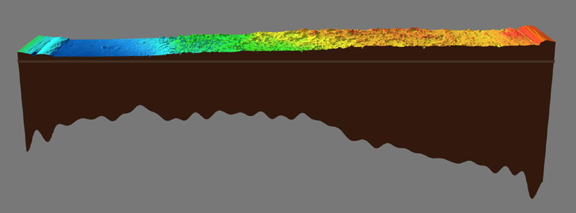 |
National Aeronautics and Space Administration Goddard Space Flight Center |
SEARCH NASA |

 MOLA MOLA |
Global slice of the crustal structure of Mars along 0° E longitude as derived from gravity and topography data from the Mars Global Surveyor spacecraft that is currently mapping the red planet. In the figure the south pole is at the far right and the north pole is at the far left. For illustrative purposes the crustal structure is vertically exaggerated and is about 40 km thick under the northern plains and 70 km thick at high southern latitudes. The sloping region under part of the southern highlands (yellow/orange) and the uniform thickness region under the northern lowlands (blue) and Arabia Terra region (green) represent two distinct crustal provinces. The global dichotomy boundary occurs at the lowlands/Arabia Terra (blue/green) transition. This boundary does not correlate with the crustal structure, which indicates that the geological manifestation of the boundary is primarily due to surfical rather than internal processes.
Additional analysis of the topography and gravity indicates that the northern lowlands was likely a zone of high heat flow early in Martian history, relecting vigorous convection of the Martian interior. This rapid heat loss could have released gases trapped within the planet to the atmosphere and underground ice or water to the surface, helping to produce a warmer, wetter climate than present on Mars today. (Credit: MGS RS and MOLA Science Teams)
Figures from the Science* Paper
* Zuber, M.T., S.C. Solomon, R.J. Phillips, D.E. Smith, G.L. Tyler, O. Aharonson, G. Balmino, W.B. Banerdt, J.W. Head, C.L. Johnson, F.G. Lemoine, P.J. McGovern, G.A. Neumann, D.D. Rowlands, S. Zhong, Internal structure and early thermal evolution of Mars from Mars Global Surveyor topography and gravity, Science, 287, 1788-1793, 2000.
Download a PDF version of the paper.
Check out some high quality visualizations from the NASA/Goddard Scientific Visualization Studio.
Read the press release.
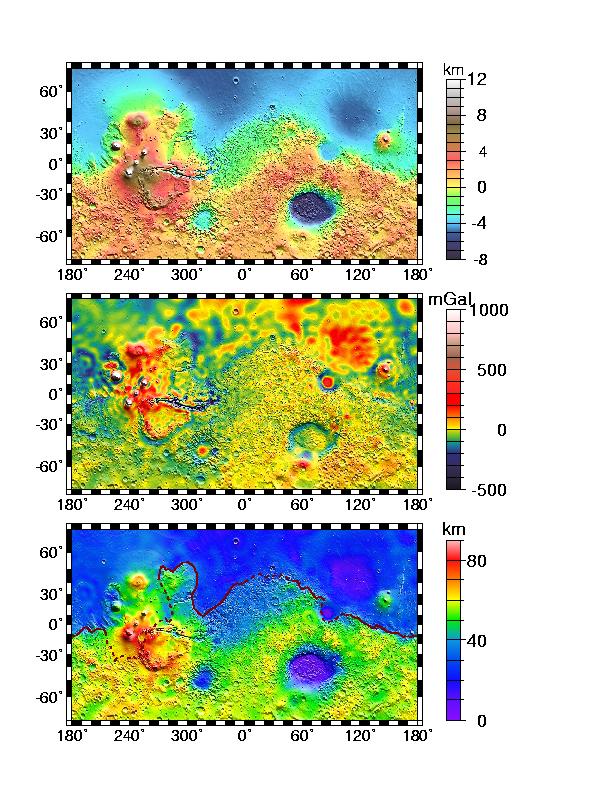
Figure 1. Global maps of (A) topography, (B) free-air gravity and (C) crustal thickness (7) of Mars (Mercator projection). On all panels the Tharsis province is centered near the equator in the longitude range 220° E to 300° E and contains the east-west trending Valles Marineris canyon system and the major volcanic shields Olympus Mons (18° N, 225° E), Alba Patera (42° N, 252° E), Ascraeus Mons (12° N, 248° E), Pavonis Mons (0°, 247° E), and Arsia Mons (9° S, 239° E). The Arabia Terra region is centered at 10° N, 10° E, the Elysium rise is at 30° N, 150° E, the Tempe Terra region lies at 40° N, 290° E, the Syria Planum region is centered at 25° S, 270° E, and the Terra Cimmeria region is centered at 60° S, 180° E. Major impact basins include Hellas (45° S, 70° E), Argyre (50° S, 320° E), Isidis (12° N, 88° E), and Utopia (45° N, 110° E). The hemispheric dichotomy boundary is shown as a red line in (C), solid where distinctively expressed and dashed where estimated. This analysis uses an areocentric coordinate convention with east longitude positive. One degree of latitude on Mars equals ~59 km. (Credit: MGS RS and MOLA Science Teams)
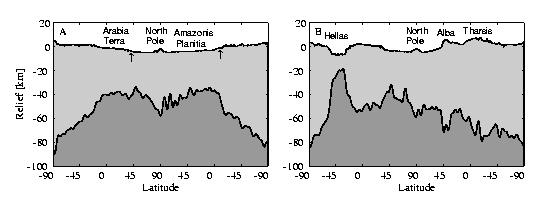
Figure 2. Circum-Mars profiles of crustal thickness along longitude lines of (A) 0° to 180° E and (B) 70° to 250° E. Light grey represents crust, and dark grey represents mantle. In the figures the south pole is at both ends of the plot, the north pole is at the center, and the lower longitude profiles (0° E and 70° E) are on the left sides of the plots. Apparent crustal thickening beneath the north and south polar regions is an artifact of the assumption that layered terrains and ice caps are composed of material with the same density as the crust rather than less dense ice plus dust. The arrows in (A) show the location of the hemispheric dichotomy boundary. The vertical exaggeration is 30:1. (Credit: MGS RS abd MOLA Science Teams)
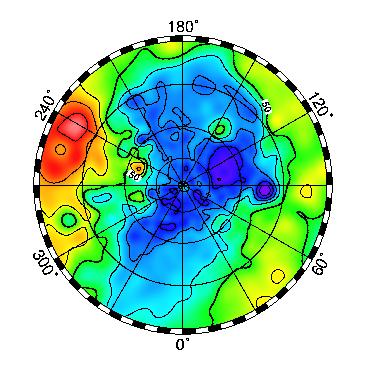
Figure 3. Polar stereographic projection of martian crustal thickness. The figure encompasses latitudes from 20° S to 90° N. (Credit: MGS RS and MOLA Science Teams)
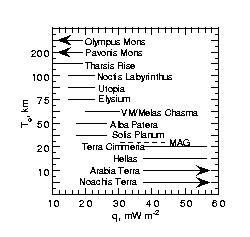
Figure 4. Effective elastic thickness Te and corresponding heat flow q obtained from lithospheric thickness inversion. Shown for comparison (dashed line) is the depth to the Curie temperature indicated from analysis of MGS magnetic data in Terra Cimmeria. (Credit: MGS RS and MOLA Science Teams)
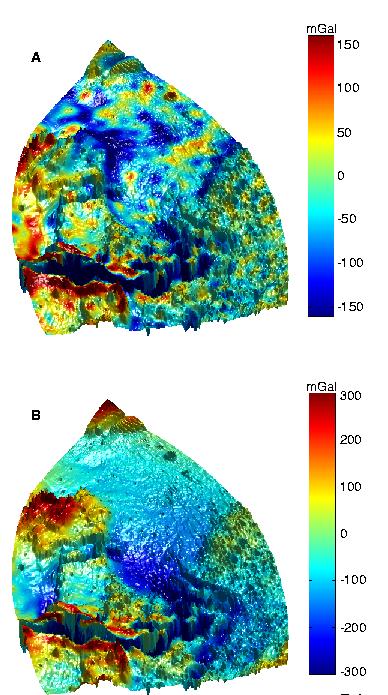
Figure 5. High-resolution gravity draped over a shaded relief map of part of the northern hemisphere showing evidence for buried channels: (A) observed free-air gravity and (B) predicted gravity due to attraction of surface topography. The fact that (A) and (B) differ indicates that the gravity lows (in blue) in the northern lowlands shown in (A) are due to subsurface mass deficit. The plot is a Hammer projection from 30° S to 90° N latitude, 270° to 360° E longitude. North is at the top of each panel. Valles Marineris is the prominent feature at the lower left. (Credit: MGS RS and MOLA Science Teams)
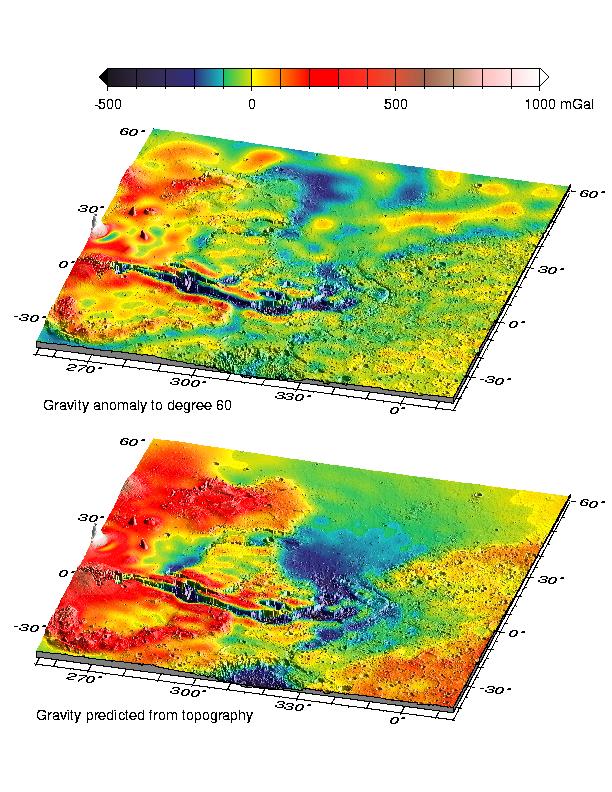
A mercator version of Figure 5. High-resolution gravity draped over a shaded relief map of part of the northern hemisphere showing evidence for buried channels: (TOP) observed free-air gravity and (BOTTOM) predicted gravity due to attraction of surface topography. The fact that the top and bottom figures differ indicates that the gravity lows (in blue) in the northern lowlands shown in the top frame are due to subsurface mass deficit. Valles Marineris is the prominent feature at the lower left of each frame. (Credit: MGS RS and MOLA Science Teams)
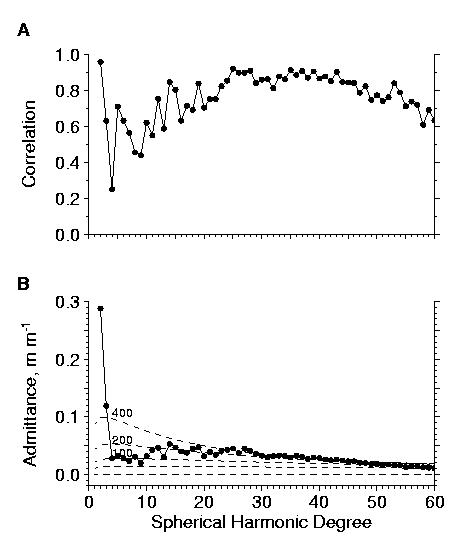
Supplementary Figure 1. (A) Coherence and (B) admittance between gravity and topography based on degree variances of the power spectral representations of the fields. The degree variances are the squares of the gravity and topography coefficients as functions of spherical harmonic degree, l. The coherence (A) is the normalized square of the correlation coefficient between power spectral amplitudes of gravity and topography. The coherence spectrum indicates that on a global basis gravity and topography are more highly correlated at short wavelengths than previously thought, as a result of the improved resolution of both fields. The admittance (B) is the response function between spectral gravity and topography. In (B) the observed admittance is compared to models for compensation by crustal thickness variations at mean depths of 400 (top), 200, 100, and 50 (bottom) km. The admittance spectrum (B) suggests that no single compensation depth is consistent with the topography, implying that multiple physical processes have contributed to the planet's evolution. The admittance reflects the interplay between variations in crustal thickness and mantle density, as well as the elastic response of the lithosphere to loading, but these effects cannot be isolated within the global average response function. To explore the geodynamic mechanisms that have shaped Mars, particularly as relevant to thermal evolution and the history of water, we perform inversions for crustal and lithosphere structure. (Credit MGS RS and MOLA Science Teams)
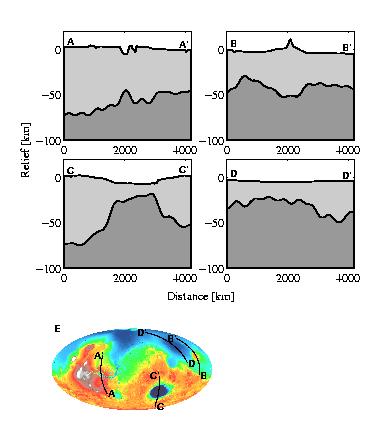
Supplementary Fig. 2. Profiles of crustal structure across: (A) Valles Marineris, (B) the Elysium rise, including the Elysium Mons volcano, and the (C) Hellas and (D) Utopia basins. Profile locations are shown in (E). The vertical exaggeration is 30:1. (Credit: MGS RS and MOLA Science Teams)
Back to MOLA home page
